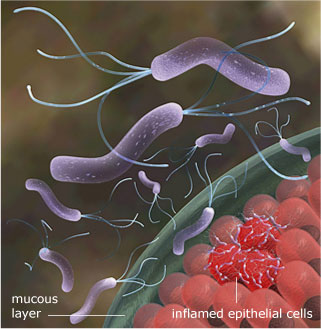
This webpage was produced as an assignment for an undergraduate course at Davidson College.
Helicobacter pylori life cycle:

Figure 1: Helicobacter pylori invading epithelial cells.
Attachment:
The Helicobacter pylori enter the stomach and attach to the protective mucus lining of the stomach wall. The bacteria are able to survive in the strongly acid environment of the stomach because they excrete the enzyme urease which neutralized the acidic environment of the stomach by converting urea into the basic ammonia and buffer bicarbonate. Inside the mucus lining of the stomach wall, the bacteria cannot be killed by the bodies immune system.
Toxin production:
The Helicobacter pylori produce toxins such as vaculating cytotoxin A (VAC A) that cause the cells in the lining of the stomach to die. This allows the bacteria to better access of nutrients as it decreases the competition from stomach lining cells.
Cell Invasion:
The bacteria invade the protective inner lining of the stomach so that they can be protected from immune system. The bacteria then kill the cells that they invade which creates holes in the mucus lining of the stomach, causing the formation of ulcers. Additionally, the substances released by the bacteria during the invasion, hurt the stomach cells ability to absorb calories from food in the stomach.
References:
Helicobacter Pylori Infection, Immune Response and Vaccination. A. Lembo, L. Caradonna, T. Magrone, M. L. Mastronardi, D. Caccavo, E. Jirillo, L. Amati.
Immunobiology: The Immune System in Health and Disease 6th ed. Charles A. Janeway Jr. et al. 2005.
Contact information: vinardone@davidson.edu